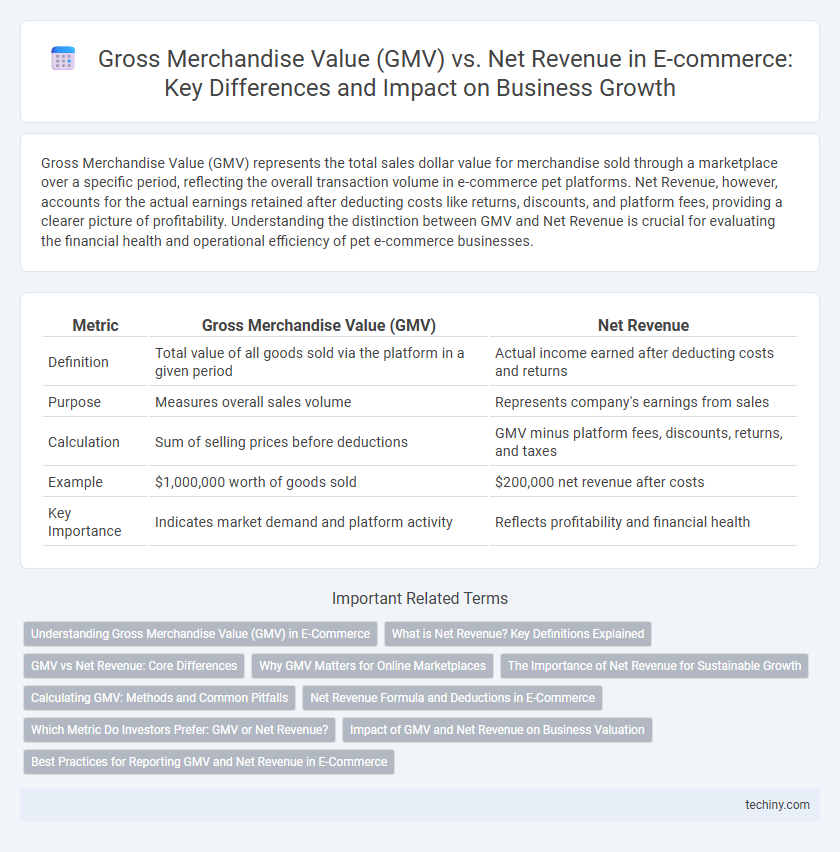Gross Merchandise Value (GMV) represents the total sales dollar value for merchandise sold through a marketplace over a specific period, reflecting the overall transaction volume in e-commerce pet platforms. Net Revenue, however, accounts for the actual earnings retained after deducting costs like returns, discounts, and platform fees, providing a clearer picture of profitability. Understanding the distinction between GMV and Net Revenue is crucial for evaluating the financial health and operational efficiency of pet e-commerce businesses.
Table of Comparison
| Metric | Gross Merchandise Value (GMV) | Net Revenue |
|---|---|---|
| Definition | Total value of all goods sold via the platform in a given period | Actual income earned after deducting costs and returns |
| Purpose | Measures overall sales volume | Represents company's earnings from sales |
| Calculation | Sum of selling prices before deductions | GMV minus platform fees, discounts, returns, and taxes |
| Example | $1,000,000 worth of goods sold | $200,000 net revenue after costs |
| Key Importance | Indicates market demand and platform activity | Reflects profitability and financial health |
Understanding Gross Merchandise Value (GMV) in E-Commerce
Gross Merchandise Value (GMV) in e-commerce represents the total sales value of merchandise sold through a marketplace over a specific period, reflecting overall transaction volume without deducting costs or returns. It serves as a key metric for assessing platform activity and market demand but differs from net revenue, which accounts for deductions such as fees, returns, and discounts. Understanding GMV enables businesses to gauge sales performance and growth potential while recognizing that net revenue provides a clearer picture of actual earnings and profitability.
What is Net Revenue? Key Definitions Explained
Net Revenue in e-commerce refers to the total income generated from sales after deducting returns, discounts, and allowances from the Gross Merchandise Value (GMV). It represents the actual earnings that contribute to profitability, excluding taxes and shipping fees, offering a clearer picture of business performance. Understanding Net Revenue is crucial for accurate financial analysis and strategic decision-making in online retail operations.
GMV vs Net Revenue: Core Differences
Gross Merchandise Value (GMV) measures the total sales dollar value for merchandise sold through a marketplace over a specific period, reflecting overall transaction volume without deducting costs or returns. Net Revenue represents the actual income retained by the e-commerce platform after deducting expenses such as discounts, returns, commissions, and shipping fees, providing a clearer view of profitability. Understanding the core differences between GMV and Net Revenue is crucial for evaluating market scale versus financial health in e-commerce business performance analysis.
Why GMV Matters for Online Marketplaces
Gross Merchandise Value (GMV) represents the total sales dollar value for merchandise sold through an online marketplace, serving as a key indicator of platform scale and customer demand. Unlike Net Revenue, which accounts for fees, returns, and discounts, GMV reflects overall transactional volume, helping investors and stakeholders assess market traction and growth potential. Emphasizing GMV enables marketplaces to attract sellers and buyers by showcasing robust activity levels, essential for network effects and competitive positioning in e-commerce ecosystems.
The Importance of Net Revenue for Sustainable Growth
Gross Merchandise Value (GMV) represents the total sales volume through an e-commerce platform, while Net Revenue accounts for actual earnings after deducting returns, discounts, and fees. Net Revenue is crucial for sustainable growth because it reflects the real profitability and cash flow available for reinvestment in marketing, infrastructure, and customer retention. Prioritizing Net Revenue over GMV ensures long-term financial health and operational efficiency in competitive e-commerce markets.
Calculating GMV: Methods and Common Pitfalls
Calculating Gross Merchandise Value (GMV) involves summing the total sales dollar value of merchandise sold through a marketplace over a specific period, without deducting returns, discounts, or cancellations. Common pitfalls include inflating GMV by counting refunded or canceled orders and failing to distinguish GMV from net revenue, which only accounts for actual earnings after subtracting costs and fees. Precision in tracking transactions and applying consistent calculation methods ensures accurate GMV reporting critical for e-commerce performance analysis.
Net Revenue Formula and Deductions in E-Commerce
Net Revenue in e-commerce is calculated by subtracting returns, discounts, and platform fees from the Gross Merchandise Value (GMV). The formula is: Net Revenue = GMV - Returns - Discounts - Transaction Fees. This metric reflects the actual income retained by the platform, providing a more accurate measure of profitability than GMV alone.
Which Metric Do Investors Prefer: GMV or Net Revenue?
Investors typically prefer Net Revenue over Gross Merchandise Value (GMV) because Net Revenue reflects the actual income a company retains after returns, discounts, and commissions, providing a more accurate measure of profitability. GMV indicates the total sales volume transacted on a platform but does not account for operating costs or revenue-sharing structures, which can inflate perceived scale. Therefore, Net Revenue offers clearer insight into a company's financial health and long-term sustainability, critical factors for investment decisions.
Impact of GMV and Net Revenue on Business Valuation
Gross Merchandise Value (GMV) represents the total sales dollar value for merchandise sold through a marketplace over a given period, serving as a key indicator of customer demand and market traction. Net Revenue, calculated after deducting returns, discounts, and taxes, more accurately reflects the actual income a business retains and directly influences profitability and cash flow. Investors often prioritize Net Revenue over GMV when assessing business valuation since sustainable profitability and revenue quality are critical for long-term growth and financial stability.
Best Practices for Reporting GMV and Net Revenue in E-Commerce
Accurately reporting Gross Merchandise Value (GMV) and Net Revenue requires clear differentiation: GMV reflects the total sales value of merchandise sold, while Net Revenue accounts for returns, discounts, and cancellations. Best practices include consistent time-frame alignment, transparent deduction methodologies, and integration of real-time data analytics to avoid overstating business performance. Utilizing standardized reporting frameworks ensures compliance with financial regulations and provides stakeholders with reliable insights into e-commerce growth and profitability.
Gross Merchandise Value (GMV) vs Net Revenue Infographic

 techiny.com
techiny.com